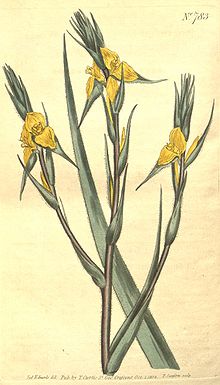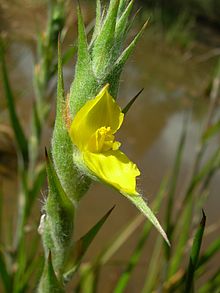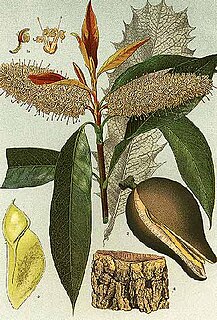
Xylomelum is a genus of six species of flowering plants, often commonly known as woody pears, in the family Proteaceae and are endemic to Australia. Plants in this genus are tall shrubs or small trees with leaves arranged in opposite pairs, relatively small flowers arranged in spike-like groups, and the fruit a woody, more or less pear-shaped follicle.

Xerochrysum bracteatum, commonly known as the golden everlasting or strawflower, is a flowering plant in the family Asteraceae native to Australia. Described by Étienne Pierre Ventenat in 1803, it was known as Helichrysum bracteatum for many years before being transferred to a new genus Xerochrysum in 1990. It is an annual up to 1 m (3.3 ft) tall with green or grey leafy foliage. Golden yellow or white flower heads are produced from spring to autumn; their distinctive feature is the papery bracts that resemble petals. The species is widespread, growing in a variety of habitats across the country, from rainforest margins to deserts and subalpine areas. The golden everlasting serves as food for various larvae of lepidopterans, and adult butterflies, hoverflies, native bees, small beetles, and grasshoppers visit the flower heads.

Blandfordia, commonly known as Christmas bells, is a genus of four species of flowering plants native to eastern Australia. Christmas bells are tufted, perennial herbs with narrow, linear leaves and up to twenty large, drooping, cylindrical or bell-shaped flowers.

Banksia meisneri, commonly known as Meisner's banksia, is a shrub that is endemic to a small area in the south-west of Western Australia. It has crowded, more or less linear leaves and in winter and spring, spikes of golden brown flowers followed by furry fruit which usually only open after fire.

Grevillea eriostachya, also known as flame grevillea, orange grevillea, or honey grevillea, is a species of flowering plant in the family Proteaceae and is endemic to western parts of Australia. It is a shrub with a leafy base, mostly linear leaves and conical groups of bright yellow flowers on long canes above the foliage.

Persoonia cornifolia is a plant in the family Proteaceae and is endemic to eastern Australia. It is a shrub with elliptic to egg-shaped leaves and hairy yellow flowers, and grows in northern New South Wales and south-eastern Queensland.

Hibbertia riparia, commonly known as erect guinea-flower, is a species of flowering plant in the family Dilleniaceae and is endemic to the south-eastern Australia. It is an erect to spreading shrub with hairy foliage, linear leaves and yellow flowers with six to sixteen stamens in a single cluster on one side of two carpels.
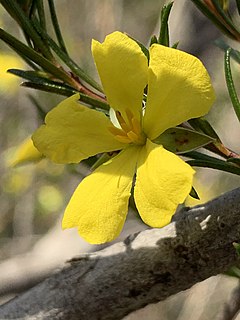
Hibbertia stricta is a species of flowering plant in the family Dilleniaceae and is endemic to New South Wales. It is a small, usually upright shrub with hairy foliage, linear leaves and yellow flowers with six or seven stamens arranged around two woolly-hairy carpels.

Chloanthes is a genus of four species of flowering plants in the family Lamiaceae and is endemic to Australia. Plants in this genus are shrubs with hairy foliage, blistered or wrinkly leaves and flowers with five petals fused at the base, usually with two "lips".

Johnsonia pubescens, commonly called the pipe lily, is a grass-like plant in the family Asphodelaceae, subfamily Hemerocallidoideae, endemic to the south-west of Western Australia. As with others in the genus, it is distinguished by its minute flowers which are on the end of a spike and hidden by large, overlapping, papery bracts.

Hemiphora elderi, commonly known as red velvet, is a flowering plant in the mint family Lamiaceae and is endemic to the south-west of Western Australia. It is a small shrub with its leaves densely covered with white, woolly hairs and with small clusters of reddish-purple, bell-shaped flowers.

Quoya dilatata is a flowering plant in the mint family Lamiaceae and is endemic to Western Australia. It is a low, spreading shrub with its branches and leaves densely covered with a layer of white, woolly hairs. The leaves are wrinkled or crinkly and the tube-shaped flowers are orange-red and hairy on the outside.
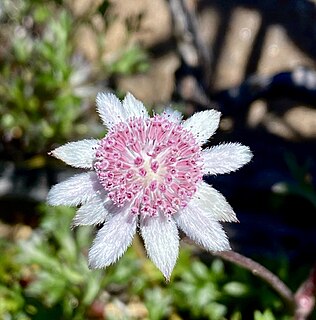
Actinotus forsythii, the pink flannel flower or ridge flannel flower), is a plant in the family Apiaceae, native to the east coast of Australia, and found in New South Wales and Victoria
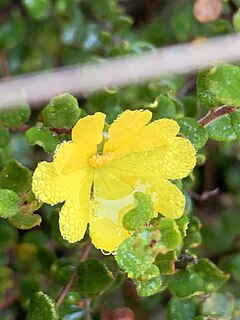
Hibbertia decumbens is a species of flowering plant in the family Dilleniaceae and is endemic to a restricted area of New South Wales. It is a spreading, almost prostrate shrub with hairy foliage, egg-shaped to almost round leaves, and yellow flowers usually with nine to twelve stamens arranged in a group on one side of two carpels.

Hibbertia patens is a species of flowering plant in the family Dilleniaceae and is endemic to south-eastern Queensland. It is a much-branched shrub with hairy foliage, linear to oblong leaves and yellow flowers arranged singly in leaf axils with 12 to 26 stamens arranged around two carpels.
Hibbertia pilulis is a species of flowering plant in the family Dilleniaceae and is endemic to Arnhem Land in the Northern Territory. It is a straggly shrub with hairy foliage, elliptic leaves and yellow flowers arranged singly in leaf axils with 34 to 46 stamens arranged in bundles around two carpels.

Hibbertia praemorsa is a species of flowering plant in the family Dilleniaceae and is endemic to southern New South Wales. It is a shrub with hairy foliage, oblong leaves and yellow flowers arranged singly on the ends of branches with seven to nine stamens on one side of two carpels.
Hibbertia tenuifolia, commonly known as narrow-leaved guinea flower, is a species of flowering plant in the family Dilleniaceae and is endemic to eastern Australia. It is a small, spreading shrublet with hairy foliage, linear leaves and yellow flowers with twelve to sixteen stamens on one side of two carpels.
Hibbertia tenuis, commonly known as Yundi guinea-flower, is a species of flowering plant in the family Dilleniaceae and is endemic to a restricted area of the Fleurieu Peninsula, South Australia. It is a delicate, low-lying to scrambling shrublet with hairy foliage, linear leaves and bright yellow flowers with four to six stamens on one side of two carpels.
Olearia arckaringensis, commonly known as Arckaringensis daisy, is a species of flowering plant in the family Asteraceae and is endemic to a restricted area of northern South Australia. It is a small, compact, rounded shrub with woolly-hairy foliage, coarsely-toothed, elliptic leaves and lavender or white and yellow, daisy-like inflorescences.
